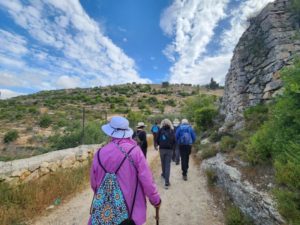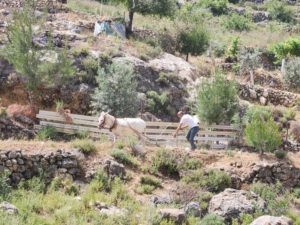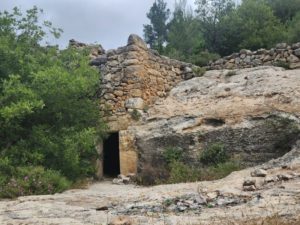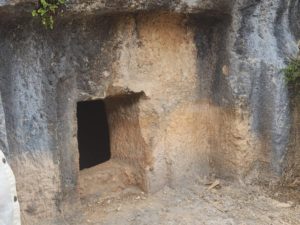Along The Path To The Village of Battir
By Ann Wilcox
On Friday, May 19, the Pilgrims of Ibillin group hiked nearly three miles to Battir, a centuries-old village near Bethlehem. With a current population of about 4,000, Battir is situated above the Jaffa-Jerusalem railway, roughly following the 1949 Green Line. It features a UNESCO World Heritage Site, consisting of terraces and an ancient Roman bath.
To get to the village, we walked on pebbled paths through a valley (or wadi). On either side were stony hills that evoked the early Roman times. One can imagine shepherds watching their flocks at the time of Jesus’ birth. We saw caves and a tomb that would have a large stone blocking the entrance – a resting place for the bones of area inhabitants. On the hillside we saw some Palestinian farmers tilling their terraced land with a simple plow pulled by a donkey. We also saw a modern “shepherd,” an Israeli settler young man with a flock of sheep and two herding dogs.
Since our arrival in Bethlehem, we have been learning about “beautiful resistance” to the occupation of these areas by Israel. This manifests in graffiti on the Separation Wall, or a children’s playground built in the shadow of the wall, at Wi’am Palestinin Conflict Transformation Center. In the Occupied Territories, residents lack control of basic resources, such as water – even though a large aquifer sits under the West Bank. Water is controlled by the Occupying Authirity for the benefit of settler communities, but Palestinians must purchase and transport water.
On the hike to Battir we saw a hillside covered with water cisterns – with drip pans attached, to gather dew water. This adds to the water resources seen in large white water tanks on the roofs of Palestinian homes and buildings. Being creative in the gathering of additional water is an example of “beautiful resistance” to the Occupation.




